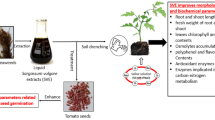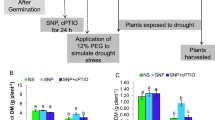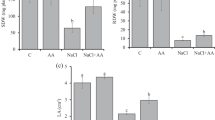Abstract
The non-protein amino acid, L-3,4-dihydroxyphenylalanine (L-DOPA), is the main allelochemical released from the roots of velvetbean and affects seed germination and root growth of several plant species. In the work presented here, we evaluated, in soybean roots, the effects of L-DOPA on the following: polyphenol oxidase (PPO), superoxide dismutase (SOD), peroxidase (POD), and catalase (CAT) activities; superoxide anion \( \left( {{\text{O}}_2^{{\bullet - }}} \right) \), hydrogen peroxide (H2O2), and melanin contents; and lipid peroxidation. To this end, 3-day-old seedlings were cultivated in half-strength Hoagland’s solution (pH 6.0), with or without 0.1 to 1.0 mM L-DOPA in a growth chamber (at 25°C, with a light/dark photoperiod of 12/12 hr and a photon flux density of 280 μmol m−2 s−1) for 24 hr. The results showed that L-DOPA increased the PPO activity and, further, the melanin content. The activities of SOD and POD increased, but CAT activity decreased after the chemical exposure. The contents of reactive oxygen species (ROS), such as \( {\text{O}}_2^{{\bullet - }} \) and H2O2, and the levels of lipid peroxidation significantly decreased under all concentrations of L-DOPA tested. These results suggest that L-DOPA was absorbed by the soybean roots and metabolized to melanin. It was concluded that the reduction in the \( {\text{O}}_2^{{\bullet - }} \) and H2O2 contents and lipid peroxidation in soybean roots was due to the enhanced SOD and POD activities and thus a possible antioxidant role of L-DOPA.




Similar content being viewed by others
Abbreviations
- CAT:
-
catalase
- L-DOPA:
-
L-3,4-dihydroxyphenylalanine
- EDTA:
-
ethylene diamide tetracetic acid
- H2O2 :
-
hydrogen peroxide
- MDA:
-
malondialdehyde
- NBT:
-
nitroblue tetrazolium
- \( {\text{O}}{{\text{H}}^{\bullet }} \) :
-
hydroxyl radical
- POD:
-
peroxidase
- PPO:
-
polyphenol oxidase
- PVPP:
-
polyvinylpolypyrrolidone
- ROS:
-
reactive oxygen species
- \( {\text{O}}_2^{{\bullet - }} \) :
-
superoxide anion
- SOD:
-
superoxide dismutase
References
Abdel-Naser, M. B., Krasagakis, K., Garbe, C., and Eberle, J. 2003. Direct effects on proliferation, antigen expression and melanin synthesis of cultured normal human melanocytes in response to UVB and UVA light. Photodermatol. Photoimmunol. Photomed. 19:122–127.
Albrecht, C., and Kohlenbach, H. W. 1990. L-DOPA content, peroxidase activity, and response to H2O2 of Vicia fava L. and V. narbonensis L. in situ and in vitro. Protoplasma. 154:144–150.
Anaya, A. L. 1999. Allelopathy as a tool in the management of biotic resources in agroecosystems. Crit. Rev. Plant Sci. 18:697–739.
Apel, K., and Hirt, H. 2004. Reactive oxygen species: metabolism, oxidative stress and signal transduction. Annu. Rev. Plant Biol. 55:373–399.
Bubna, G. A., Lima, R. B., Zanardo, D. Y. L., Dos Santos, W. D., Ferrarese, M. L. L., and Ferrarese-Filho, O. 2011. Exogenous caffeic acid inhibits the growth and enhances the lignification of the roots of soybean (Glycine max). J. Plant Physiol. doi:10.1016/j.jplph.2011.03.005.
Cakmak, I., and Horst, W. J. 1991. Effect of aluminum on lipid peroxidation, superoxide dismutase, catalase, and peroxidase activities in root tips of soybean (Glycine max). Physiol. Plant. 83:463–468.
Doblinski, P. M. F., Ferrarese, M. L. L., Huber, D. A., Scapim, C. A., and Ferrarese-Filho, O. 2003. Peroxidase and lipid peroxidation of soybean roots in response to p-coumaric and p-hydroxibenzoic acids. Braz. Arch. Biol. Technol. 46:193–198.
Fujii, Y. 1999. Allelopathy of hairy vetch and Mucuna; their application for sustainable agriculture, pp. 289–300, in C. H. Chou (ed.). Biochemistry and Allelopathy from Organisms to Ecosystems in the Pacific. Academic Sinica, Taipei.
Fujii, Y., Shibuya, T., and Yasuda, T. 1991. L-3,4-dihydroxyphenylalanine as an allelochemical candidate from Mucuna pruriens (L.) DC. var. utilis. Agric. Biol. Chem. 55:617–618.
Furubayashi, A., Hiradate, S., and Fujii, Y. 2005. Adsorption and transformation reactions of L-DOPA in soils. Soil Sci. Plant Nutr. 51:819–825.
Giannopolitis, C. N. and Ries, S. K. 1977. Superoxide dismutases occurrence in higher plants. Plant Physiol. 59:309–314.
Gill, S. S. and Tuteja, N. 2010. Reactive oxygen species and antioxidant machinery in abiotic stress tolerance in crop plants. Plant Physiol. Biochem. 48:909–930.
Golisz, A., Sugano, M., Hiradate, S., and Fujii, Y. 2011. Microarray analysis of Arabidopsis plants in response to allelochemical L-DOPA. Planta. 233:231–240.
Gülçin, I. 2007. Comparison of in vitro antioxidant and antiradical activities of L-tyrosine and L-Dopa. Amino Acids. 32:431–438.
Hachinohe, M., and Matsumoto, H. 2005. Involvement of reactive oxygen species generated from melanin synthesis pathway in phytotoxic action of L-dopa. J. Chem. Ecol. 31:237–246.
Hachinohe, M., and Matsumoto, H. 2007a. Involvement of melanin synthesis and reactive oxygen species in phytotoxic action of L-DOPA in carrot cells. Crop Prot. 26:294–298.
Hachinohe, M., and Matsumoto, H. 2007b. Mechanism of selective phytotoxicity of L-3,4-dihydroxyphenylalanine (L-DOPA) in barnyardglass and lettuce. J. Chem. Ecol. 33:1919–1926.
Hachinohe, M., Sunohara, Y., and Matsumoto, H. 2004. Absorption, translocation and metabolism of L-DOPA in barnyard grass and lettuce: their involvement in species-selective phytotoxic action. Plant Growth Reg. 43:237–243.
Hsu, Y. T. and Kao, C. H. 2007. Heat shock-mediated H2O2 accumulation and protection against Cd toxicity in rice seedlings. Plant Soil. 300:137–147.
Kruk, L., Lichszteld, K., Bounias, M., Kladna, A., and Krubera-Nowakowska, L. 1999. Formation of active oxygen species during autoxidation of DOPA. Chemosphere. 39:443–453.
Moller, I. M., Jensen, P. E., and Hansson, A. 2007. Oxidative modifications to cellular components in plants. Annu. Rev. Plant Biol . 58:459–481.
Muñoz-Muñoz, J. L., Acosta-Motos, J. R., Garcia-Molina, F., Varon, V., Garcia-Ruíz, P. A., Tudela, J., Cargia-Cánovas, F., and Rodrígues-López, J. N. 2010. Tyrosinase inactivation in its action on Dopa. Biochim. Biophys. Acta. 1804:1467–1475.
Nishihara, E., Parvez, M. M. Araya, H., and Fujii, Y. 2004. Germination growth response of different plant species to the allelochemical L-3,4-dihydroxyphenylalanine (L-DOPA). Plant Growth Reg. 42:181–189.
Nishihara, E., Parvez, M. M. Araya, H., Kawashima, S., and Fujii, Y. 2005. L-3-(3,4-dihydroxyphenyl)alanine (L-DOPA), an allelochemical exuded from velvetbean (Mucuna pruriens) roots. Plant Growth Reg. 45:113–120.
Oktay, M., Küfreviolu, I., Kocaçalişkan, I., and Şakirolu, H. 1995. Polyphenoloxidase from Amasya apple. J. Food Sci. 60:494–496.
Pattison, D. I., Dean, R. T., and Davies, M. J. 2002. Oxidation of DNA, proteins and lipids by DOPA, protein-bound DOPA, and related catechol(amine)s. Toxicology. 177:23–37.
Randhir, R., Vattem, D. A., and Shetty, K. 2006. Antioxidant enzyme response studies in H2O2 stressed porcine muscle tissue following treatment with fava bean sprout extract and L-DOPA. J. Food Biochem. 30:671–698.
Rehr, S. S., Janzen, D. H., and Feeny, P. P. 1973. L-DOPA in legume seeds: a chemical barrier to insect attack. Science. 181:81–82
Reigosa, M. J. and Pazos-Malvido, E. 2007. Phytotoxic effects of 21 plant secondary metabolites on Arabidopsis thaliana germination and root growth. J. Chem. Ecol. 33:1456–1466.
Riley, P. A. 1997. Melanin. Int. J. Biochem. Cell Biol. 29:1235–1239.
Soares, A. R., Ferrarese, M. L. L., Siqueira, R. C., Böhm, F. M. L. Z., and Ferrarese-Filho, O. 2007. L-DOPA increases lignification associated with Glycine max root growth-inhibition. J. Chem. Ecol. 33:265–275.
Spencer, J. P., Jenner, A., Butler, J., Aruoma, O. I., Dexter, D. T., Jenner, P., and Halliwell, B. 1996. Evaluation of the pro-oxidant and antioxidant actions of L-DOPA and dopamine in vitro: implications for Parkinson’s disease. Free Radic. Res. 24:95–105.
Tada, M., Rohno, M., and Niwano, Y. 2010. Scavenging or quenching effect of melanin on superoxide anion and singlet oxygen. J. Clin. Biochem. Nutr. 46:224–228.
Tománkóva, K., Luhová, L., Petrvalsky, M., Pec, P., and Lebeda, A. 2006. Biochemical aspects of reactive oxygen species formation in the interaction between Lycopersicon spp. and Oidium neolycopersici. Physiol. Mol. Plant Pathol. 68:22–32.
Topal, S., and Kocaçalişkan, I. 2006. Allelopathic effects of DOPA against four weed species. DPÜ Fen Bil. Enst. Dergisi. 11:27–32.
Tu, Y. G., Sun, Y. A., Tian, Y. G., Xie, M. Y., and Chen, J. 2009. Physicochemical characterisation and antioxidant activity of melanin from the muscles of taihe black-bone silky fowl (Gallus gallus domesticus Brisson). Food Chem. 114:1345–1350.
Wang, Z., Dillon, J., and Gaillard, E. R. 2006. Antioxidant properties of melanin in retinal pigment epithelial cells. Photochem. Photobiol. 82:474–479.
Weir, T. L., Park, S. W., and Vivanco, J. M. 2004. Biochemical and physiological mechanisms mediated by allelochemicals. Curr. Opin. Plant Biol. 7:472–479.
Wu, Y. X., and Von Tiedemann, A. 2002. Impact of fungicides on active oxygen species and antioxidant enzymes in spring barley (Hordeum vulgare L.) exposed to ozone. Environ. Pollut. 116:37–47.
Zanardo, D. I. L., Lima, R. B., Ferrarese, M. L. L., Bubna, G. A., and Ferrarese-Filho, O. 2009. Soybean root growth inhibition induced by p-coumaric acid. Environ. Exp. Bot. 66:25–30.
Acknowledgements
M.L.L. Ferrarese and O. Ferrarese-Filho are research fellow of CNPq (Brazilian Council for Scientific and Technological Development). A.R. Soares is the recipient of a CNPq fellowship. The technical assistance of Aparecida M. D. Ramos and the financial support of the CNPq are gratefully acknowledged. We also express our gratitude to the two reviewers for their constructive comments.
Author information
Authors and Affiliations
Corresponding author
Rights and permissions
About this article
Cite this article
Soares, A.R., de Lourdes Lucio Ferrarese, M., de Cássia Siqueira-Soares, R. et al. The Allelochemical L-DOPA Increases Melanin Production and Reduces Reactive Oxygen Species in Soybean Roots. J Chem Ecol 37, 891–898 (2011). https://doi.org/10.1007/s10886-011-9988-2
Received:
Revised:
Accepted:
Published:
Issue Date:
DOI: https://doi.org/10.1007/s10886-011-9988-2




